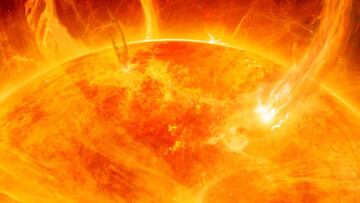Solar storm predicted by NASA, what damage could the flare cause?
A NASA forecast model used by scientist Tamitha Skov anticipates a solar flare hitting the Earth on 19 July 2022. that “could cause interference in radio and GPS signals.”

A solar storm will hit Earth early this Tuesday, July 19, 2022. The warning comes from a NASA forecast model applied by the scientist Tamitha Skov, who has described this flare phenomenon as a filament in the shape of a snake coming from the Sun .
The scientist herself shared this forecast last Saturday through her Twitter profile. The main consequences that could be caused by the impact of this “direct hit” are interference with radio and GPS signals. Some signal outages could occur particularly on the night side of our planet, as Skov explained. Another effect caused by these solar storms is the appearance of auroras.
Direct Hit! A snake-like filament launched as a big #solarstorm while in the Earth-strike zone. NASA predicts impact early July 19. Strong #aurora shows possible with this one, deep into mid-latitudes. Amateur #radio & #GPS users expect signal disruptions on Earth's nightside. pic.twitter.com/7FHgS63xiU
— Dr. Tamitha Skov (@TamithaSkov) July 16, 2022
The auroras are a phenomenon in the form of luminescence that occurs when there is an interaction between the particles expelled by the Sun, with the molecules of the atmosphere concentrated at a height ranging between 95 and 750 kilometers, an area where there is enough atmospheric density for that light radiation to be seen. In addition, these flares are accompanied by X-rays that are usually absorbed in the first layer of the atmosphere.
In other news:
- Revealed: Russia’s ‘ghost ship’ tactic evades detection
- How to save on gasoline with a Google Maps trick
- How to download James Webb space telescope photos on your phone or computer
However, interference in the propagation of radio waves could occur if this radiation has enough energy to heat and distort the ionosphere, which is that part of the earth’s atmosphere that is permanently ionized by photoionization from solar radiation. In other words, in a truly worst case scenario, a massive solar storm of these characteristics could cause our entire communications network to be out of service.
However, as Skov explains, there is a scale to measure the strength of these geomagnetic storms and they range from level G1 to G5, in order to analyze the intensity and effects of the storms. According to the National Geographic Institute (IGN) on its website, these values are related to the values of the Kp index (global auroral activity indicator) reached, and indicates the frequency average with which they appear in each solar cycle.
The long snake-like filament cartwheeled its way off the #Sun in a stunning ballet. The magnetic orientation of this Earth-directed #solarstorm is going to tough to predict. G2-level (possibly G3) conditions may occur if the magnetic field of this storm is oriented southward! pic.twitter.com/SNAZGMmqzi
— Dr. Tamitha Skov (@TamithaSkov) July 16, 2022
"The magnetic orientation of this solar storm is going to be difficult to predict. G2 (possibly G3) level conditions may occur if the magnetic field of this storm is oriented to the south," explained the scientist from NASA in another tweet.
A solar cycle that started at the end of 2019
Related stories
This phenomenon is part of a solar cycle that began at the end of 2019. These solar storms are fairly common, the best known for being one of the most intense on record is the so-called ‘Carrington Storm’ in 1859, named after the astronomer Richard Carrington, who witnessed the event.
The IGN has highlighted that the frequency with which geomagnetic storms occur “is related to the periods of solar activity”, whose average cycle duration is about 11 years. The number of sunspots allows us to quantify the solar activity at any given moment.

